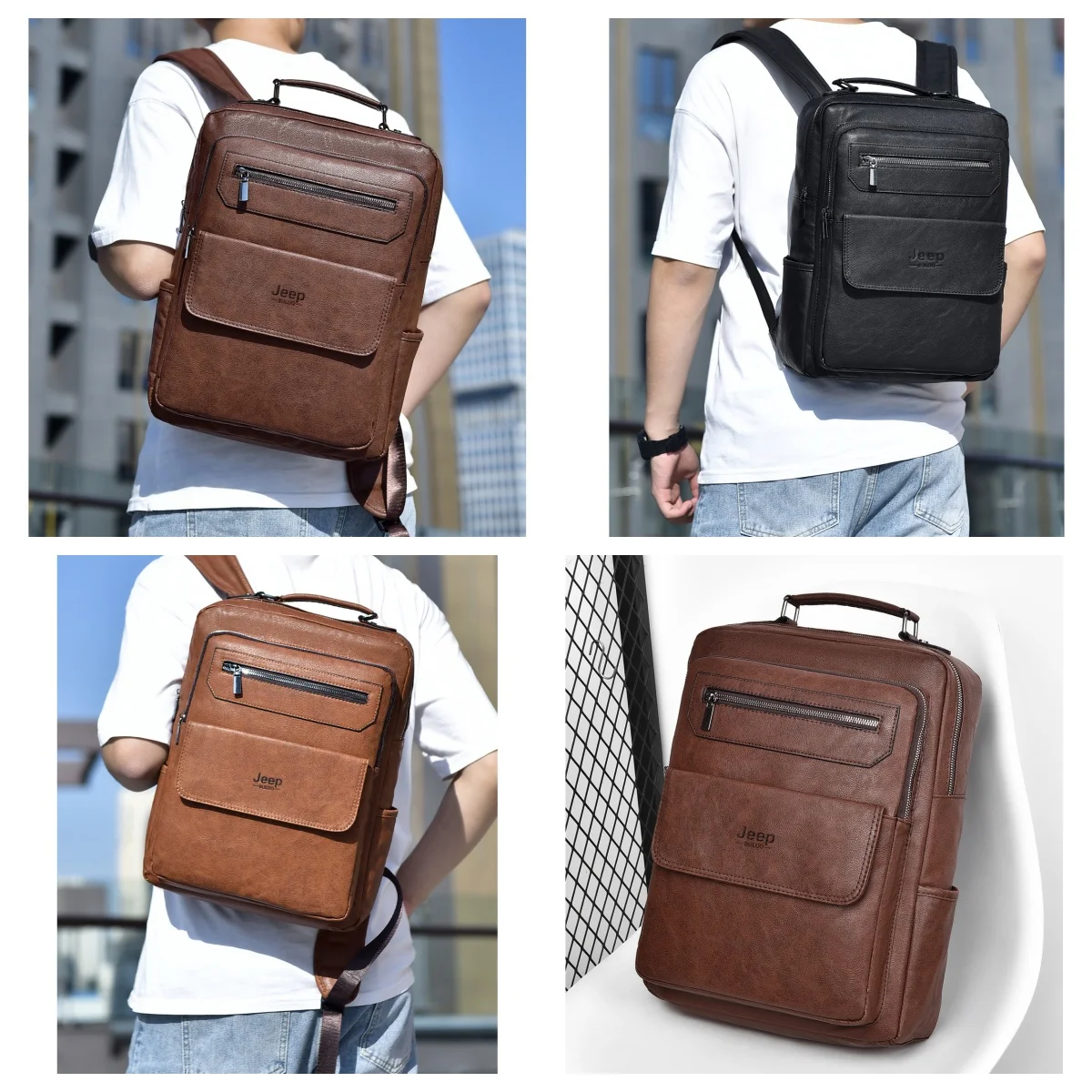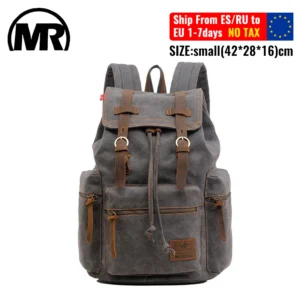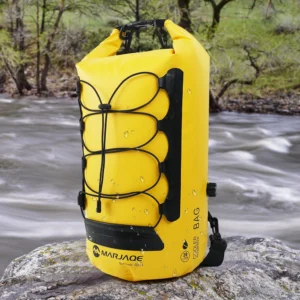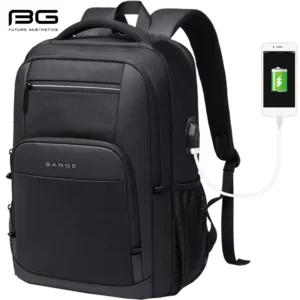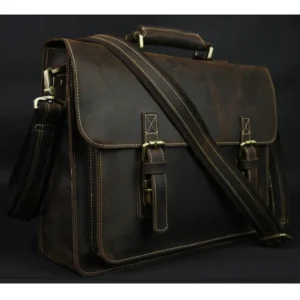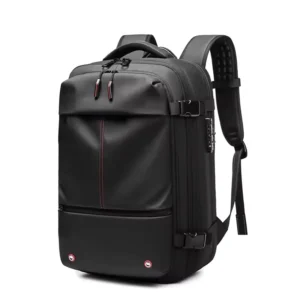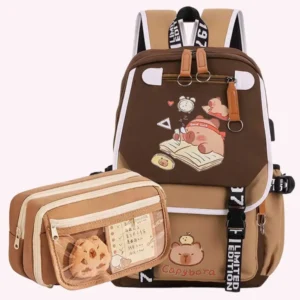Introduction to Roll Top Leather Backpacks
Roll top leather backpacks represent the perfect marriage between traditional leatherworking craftsmanship and modern functional design. These distinctive bags feature a unique closure system where the top of the bag rolls down and secures with buckles or hooks, creating a versatile and weatherproof seal.
What sets roll top leather backpacks apart from conventional designs is their remarkable adaptability. Unlike fixed-volume backpacks with standard zippered closures, roll tops can expand or contract based on your carrying needs. When you need extra space, simply roll the top fewer times; when carrying less, roll it further down for a more compact profile.
The popularity of these backpacks continues to grow among diverse users – from urban professionals seeking sophisticated everyday carry solutions to travelers requiring adaptable storage and outdoor enthusiasts appreciating weather resistance. Their distinctive silhouette also makes a style statement that stands apart from mass-produced bag designs.
Roll top leather backpacks offer four key advantages: exceptional durability from quality leather construction, adjustable capacity that adapts to your needs, superior weather protection from the sealed closure, and a timeless aesthetic that improves with age.
This comprehensive guide will help you understand what makes these backpacks special, explore their unique features, and determine if this style meets your specific needs.
The Distinctive Roll Top Closure System
The roll top closure system is what truly distinguishes these backpacks from conventional designs. This ingenious mechanism involves folding the top opening of the bag over itself multiple times and then securing it with buckles, hooks, or straps. The design originated from waterproof dry bags used in outdoor activities but has evolved into a sophisticated feature in premium leather goods.
The engineering behind roll tops is remarkably effective in its simplicity. By creating multiple folds of material, the system establishes a natural barrier against the elements while eliminating the vulnerability of zippers. The mechanics of rolling create a tight seal that grows more secure with each fold.
Key advantages of the roll top design include:
- Expandable capacity: The adjustable nature of the roll top allows the bag to expand by 30-50% from its compressed state, adapting to varying load requirements
- Superior weather protection: The rolled and secured closure creates a naturally water-resistant seal without relying on zipper flaps or coatings that can fail
- Enhanced security: Unlike zippers that can be forced open, properly secured roll tops require deliberate unbuckling, making casual theft significantly more difficult
- Clean aesthetic appeal: The minimalist design eliminates bulky hardware and creates a sleek, distinctive silhouette
Roll top variations include single-buckle designs that emphasize simplicity, dual-buckle systems offering greater security and stability, and hook-based closures that provide quick access. Some premium designs incorporate a combination of systems, such as a roll top with a magnetic closure underneath for additional convenience.
The physical principle behind roll tops creates an inherent water barrier – each fold effectively doubles the material protecting the contents, while the rolling action creates a natural downward path for water to flow away from the opening. This makes waterproof features in leather backpacks particularly effective when combined with roll top designs.
Premium Leather Quality and Types
The leather quality used in a roll top backpack fundamentally determines its durability, appearance, and how it will age over time. Understanding different leather types helps you make an informed choice aligned with your priorities and budget.
Full-Grain Leather
The highest quality option available, full-grain leather includes the entire top layer of the hide with all its natural grain intact. Nothing is removed through sanding or buffing, preserving the strongest fibers in the material. This results in exceptional durability and a surface that develops a rich patina over time, telling the story of your journeys together. While initially stiffer and sometimes showing natural marks or variations, full-grain leather offers unmatched longevity and character development.
Top-Grain Leather
Top-grain represents the second-highest quality, created by lightly sanding the outermost layer of the hide to remove imperfections. This process results in a more uniform appearance and increased suppleness compared to full-grain, while still maintaining good durability. Top-grain leather is more flexible initially and requires less break-in time, though it won’t develop quite the same depth of character as full-grain over years of use.
Genuine Leather
Despite its name suggesting authenticity, “genuine leather” typically indicates lower quality material made from the layers remaining after the top portions have been removed. Often treated with heavy dyes and finishes to mask its lower quality, genuine leather lacks the structural integrity and aging characteristics of higher grades. While more affordable, backpacks made from genuine leather generally won’t hold up to years of regular use.
Tanning Processes
The method used to turn raw animal hide into usable leather significantly impacts the final product:
Vegetable tanning uses natural tannins from plant materials in a traditional, environmentally friendly process. This method produces leather with rich, warm coloration that develops excellent patina but requires more care to maintain water resistance.
Chrome tanning employs chromium salts for faster production, creating leather that’s more initially water-resistant and flexible. While practical, it lacks some of the character development and unique scent of vegetable-tanned options.
High-quality full-grain leather backpacks represent an investment in longevity. When properly cared for, premium leather can last decades rather than years, developing increasing character with use instead of wearing out.
| Leather Type | Durability | Patina Development | Initial Feel | Water Resistance | Maintenance Needs |
|---|---|---|---|---|---|
| Full-Grain | Excellent | Exceptional | Firm, natural | Moderate (improves with treatment) | Moderate |
| Top-Grain | Very Good | Good | Smoother, supple | Good | Moderate |
| Genuine | Fair | Limited | Varies widely | Fair | High |
Craftsmanship and Construction Techniques
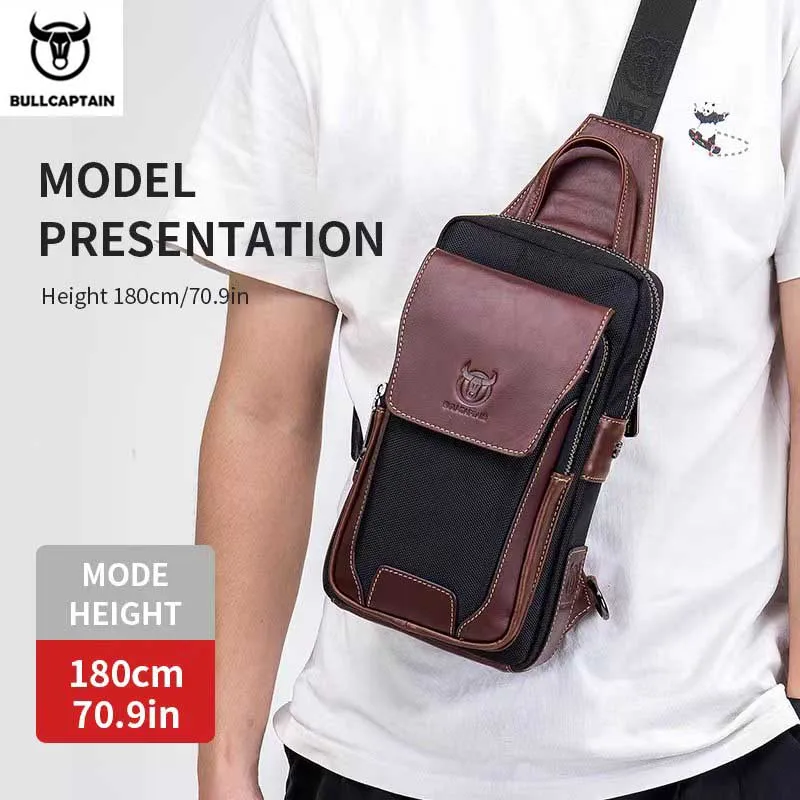
The construction methods used in a roll top leather backpack are just as important as the materials themselves. Superior craftsmanship transforms excellent leather into an heirloom-quality bag that maintains its structural integrity through years of daily use.
Stitching Quality
The stitching used in premium leather backpacks serves both functional and aesthetic purposes. Hand-stitching, while time-consuming and expensive, creates exceptionally strong seams that can self-repair minor damage. When a single thread in machine stitching breaks, the entire seam can gradually unravel; in contrast, properly executed hand-stitching remains secure even if individual stitches fail.
Many high-end manufacturers employ saddle stitching for critical stress points – a technique where two needles pass through the same hole from opposite directions, creating an interlocking stitch nearly impossible to unravel even with significant wear.
Edge Treatment
How a manufacturer finishes the edges of leather panels reveals much about their attention to detail. Premium luxury leather backpacks feature burnished edges – a labor-intensive process where the edge is polished smooth, sealed with natural waxes, and sometimes painted to match the leather color. This creates a refined appearance and prevents fraying or delamination over time.
Reinforcement Methods
Quality backpacks incorporate reinforcement at high-stress areas:
- Double-layered leather at the base and handle attachments
- Rivets to secure straps where stitching alone might fail under load
- Bar-tack stitching (dense, reinforced zigzag pattern) at critical stress points
- Interior backing material to maintain shape without adding excessive weight
Lining Considerations
The interior lining of a leather backpack significantly impacts both durability and user experience. Premium options include:
- Canvas linings that offer durability and ease of cleaning
- Twill or herringbone patterns that resist tearing better than plain weaves
- Leather-lined compartments for items requiring additional protection
- Cotton blends that balance weight, breathability and strength
Quality craftsmanship becomes particularly evident at junctions where multiple pieces meet – such as where the roll top mechanism connects to the main body, or where straps join the back panel. In well-made backpacks, these connections appear seamless and solid, with reinforced stitching and often additional hardware support.
Ergonomics and Comfort Features
A beautiful leather backpack quickly loses its appeal if it causes discomfort during extended wear. Premium roll top designs incorporate sophisticated ergonomic elements that distribute weight properly and accommodate different body types and carrying scenarios.
Shoulder Strap Design
The shoulder straps represent the primary interface between your body and the backpack, making their design crucial for comfort:
Materials: High-quality leather straps padded with foam or felt offer durability and comfort. Some manufacturers use canvas on the body-facing side to prevent sweat accumulation while maintaining leather on visible portions.
Padding: Effective padding distributes pressure across a wider area, preventing the straps from digging into shoulders. The best designs taper the padding – thicker where pressure concentrates near the top of the shoulder, gradually reducing where less support is needed.
Adjustability: Quality backpacks feature multiple adjustment points that allow customization for different torso lengths and preferred carrying positions. This ensures the backpack sits properly on your back regardless of your height or build.
Width and Contour: Wider straps distribute weight more effectively than narrow ones. Premium designs also incorporate subtle contours that follow the natural shape of the shoulder rather than using straight straps.
Back Panel Engineering
The area of the backpack that rests against your back significantly impacts comfort, especially during warm weather or extended wear:
Padding Systems: Strategic padding provides comfort while maintaining proper airflow. Some designs incorporate channels or ridges that create ventilation space between your back and the pack.
Ergonomic Shaping: Quality back panels curve slightly to match the natural contour of the spine rather than presenting a completely flat surface.
Structural Support: Internal reinforcement prevents the contents of your backpack from pressing uncomfortably against your back, particularly important when carrying laptops or other flat, rigid items.
Understanding proper backpack weight distribution techniques helps maximize comfort regardless of what you’re carrying. Proper loading places heavier items closer to your back and higher in the pack, using physics to minimize strain on your shoulders and back.
Additional Comfort Elements
Premium roll top leather backpacks often include:
Sternum Straps: Adjustable chest straps that connect the shoulder straps, preventing them from sliding outward and improving stability with heavier loads.
Carry Handles: Well-designed top handles allow alternative carrying options when navigating crowds or storing the backpack.
Back Cushioning: Breathable materials that provide padding while minimizing heat buildup against the body.
These ergonomic features transform a stylish accessory into a practical daily companion that remains comfortable throughout long commutes, travel days, or outdoor adventures.
Intelligent Storage and Organization
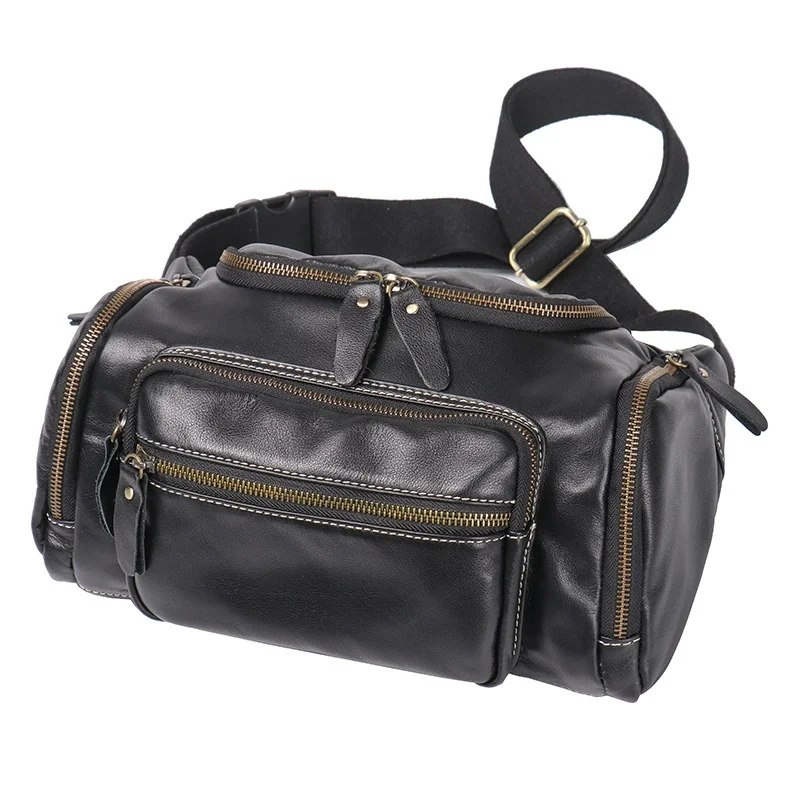
The internal organization of a roll top leather backpack determines its practical functionality for daily use. Thoughtful compartmentalization transforms a simple sack into an efficient tool for modern life, keeping essentials accessible and protected.
Main Compartment Design
The primary storage space in roll top backpacks offers unique advantages:
Adaptive Volume: Unlike fixed compartments, the roll top design allows the main chamber to expand vertically when needed. This typically provides 20-40% additional capacity compared to the bag’s compressed state.
Accessibility: The wide opening created when the top is fully unrolled provides superior visibility and access compared to narrow-mouthed backpacks. This makes packing and retrieving items significantly easier.
Typical Capacities: Most roll top leather backpacks offer between 18-30 liters of storage in their standard configuration, with premium models focusing on optimal organization rather than maximizing raw volume.
Technology Protection Features
Modern leather laptop backpacks incorporate specialized compartments to protect valuable electronics:
Laptop Sleeves: Padded compartments typically accommodate devices up to 15-16 inches, with premium designs featuring microfiber linings that prevent scratches and suspended construction that prevents impact damage if the bag is set down roughly.
Tablet Pockets: Dedicated sleeves for tablets or e-readers, often with softer linings to protect screens from scratches.
Cable Management: Thoughtfully designed pockets and loops keep charging cables, power banks, and adapters organized and accessible without tangling.
Internal Organization Systems
Quality backpacks feature organized compartments that balance accessibility with security:
Security Pockets: Hidden compartments positioned against your back to store valuables like wallets and passports, making them inaccessible to others while worn.
Document Storage: Flat pockets designed to keep papers and notebooks unwrinkled and easily accessible.
Small Item Organization: Pen loops, card slots, and key clips that prevent smaller essentials from disappearing into the depths of your backpack.
External Access Features
Well-designed roll tops balance security with convenience through:
Quick-Access Pockets: External compartments that don’t require opening the main roll top, perfect for items you need frequently like transit cards or phones.
Side Pockets: Expandable compartments ideal for water bottles or compact umbrellas, often with elastic or adjustable closures to secure contents.
Front Organizational Panels: Some designs incorporate front pockets with multiple internal dividers for frequently-accessed smaller items.
The most effective organization systems maintain clean aesthetics while providing practical functionality – hidden zippers, magnetic closures, and thoughtfully positioned compartments that don’t disrupt the backpack’s clean lines.
Hardware and Durability Elements
The hardware components of a roll top leather backpack might seem like minor details, but they often determine long-term durability and user experience. Quality metal fittings not only enhance functionality but also contribute to the bag’s premium aesthetic as they develop a patina alongside the leather.
Buckle and Clasp Systems
The closure hardware on roll top designs serves both functional and aesthetic purposes:
Materials: Brass and solid stainless steel offer superior durability compared to zinc alloy or plated alternatives. Premium buckles maintain their finish even after years of use, while cheaper options may chip or corrode.
Closure Types: Traditional roller buckles provide classic appeal but require more time to operate. Quick-release systems offer convenience, though they add mechanical complexity. Magnetic closures provide the fastest access but may offer less security.
Attachment Methods: Quality backpacks secure buckles with reinforced leather tabs, often with rivets in addition to stitching to prevent the hardware from tearing free under stress.
Zipper Selection
While the main compartment typically uses the roll top closure, secondary pockets often incorporate zippers:
YKK Zippers: The industry standard for quality, these Japanese-made zippers offer reliable operation and resistance to separation or jamming.
Weather Resistance: Better backpacks feature water-resistant zippers with protective flaps or coatings on external pockets to prevent moisture intrusion.
Self-Healing vs. Metal: Self-healing nylon coil zippers offer smoother operation but less durability than metal options, which provide greater strength but may be heavier and less flexible.
Reinforcement Elements
Durable leather backpacks for commuters incorporate specific reinforcements at failure points:
Rivets: Metal fasteners that connect layers of leather in high-stress areas like strap attachments, preventing separation even under heavy loads.
Bottom Reinforcement: Quality backpacks feature double-layered bases or protective feet to prevent wear from setting the bag on various surfaces.
Edge Protection: Critical edges may incorporate additional support through folded construction or reinforcing materials to maintain shape over time.
The weight and feel of hardware provides tangible feedback about backpack quality – substantial, smooth-operating buckles and zippers with positive engagement suggest attention to detail throughout the construction process.
Water Resistance and Protection Features
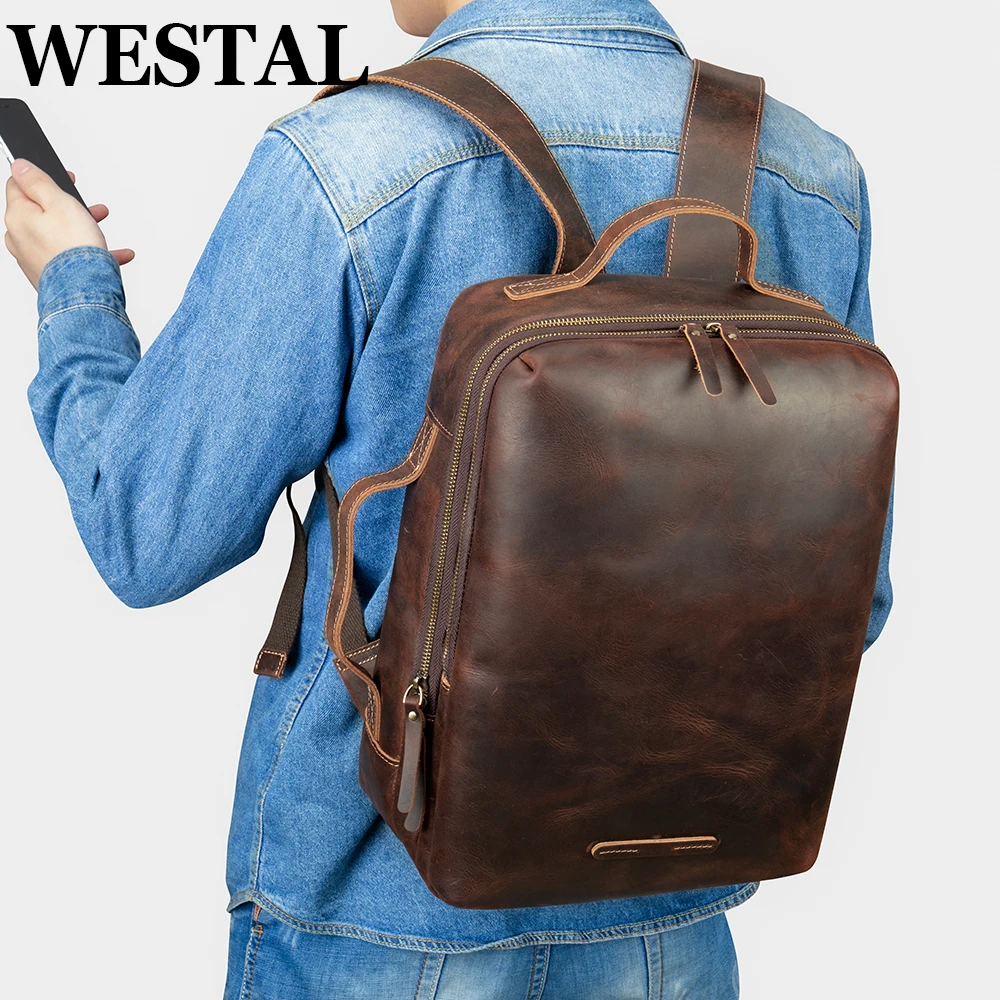
One of the roll top design’s greatest advantages is its inherent water resistance, making these backpacks particularly suitable for unpredictable weather conditions. While no leather product is completely waterproof without sacrificing its natural characteristics, several features enhance protection from the elements.
Roll Top Water Resistance Mechanics
The physics behind roll top water protection is elegantly simple yet effective:
- Multiple folds create overlapping layers that water must penetrate
- The downward roll directs water away from the opening rather than toward it
- The secured closure maintains tension that prevents gaps from forming
This natural barrier functions much like a watershed on a roof, channeling moisture away from vulnerable areas rather than trying to create an impermeable barrier that would compromise leather’s breathability.
Leather Treatment Options
Various applications enhance leather’s natural water resistance:
Waxed Finishes: Traditional waxes create a hydrophobic barrier that causes water to bead up and roll off rather than penetrating the leather. These treatments maintain the material’s natural appearance while adding significant water protection.
Modern Treatments: Silicone-based products provide excellent water repellency with less maintenance than traditional options but may alter the leather’s natural feel slightly.
Oiling leather helps restore natural water resistance while conditioning the material. Oils penetrate the fibers, displacing water that would otherwise be absorbed.
Understanding various leather waterproofing products helps you choose the right protection method for your specific backpack type.
Additional Protection Elements
Premium roll top backpacks incorporate several features that enhance weather resistance:
Seam Sealing: Specialized techniques that prevent water from penetrating stitch holes, including waterproof thread, sealed seams, or interior backing.
Water-Resistant Linings: Internal materials that provide a secondary moisture barrier, particularly important for protecting electronics.
Drainage Design: Thoughtful construction that prevents water pooling in external pockets or at the bottom of the bag.
For complete protection in extreme conditions, consider following a comprehensive guide to waterproofing leather bags that addresses all aspects of water resistance.
It’s important to understand leather’s limitations – while proper treatment significantly improves weather resistance, no leather product should be submerged or exposed to prolonged heavy rain without accepting some risk of damage. The goal is practical water resistance for everyday conditions rather than complete waterproofing that would compromise leather’s natural properties.
Aesthetic Design Elements and Style
The visual appeal of roll top leather backpacks extends beyond mere fashion – their aesthetic qualities reflect functional design choices and traditional craftsmanship. These backpacks typically fall into several design languages, each balancing form and function in different ways.
Design Approaches
Roll top leather backpacks generally embody one of several distinct aesthetic philosophies:
Minimalist Modern: Clean lines, subtle hardware, and monochromatic color schemes create sophisticated designs perfect for urban professionals. These backpacks emphasize simplicity with hidden pockets and understated branding.
Heritage/Vintage: Drawing inspiration from historical rucksack designs, these vintage leather backpacks feature prominent hardware, visible stitching, and details that reference traditional leatherworking. The aesthetic suggests durability and timeless appeal rather than trendy styling.
Urban Professional: Refined designs that balance sophistication with practicality, often incorporating subtle technical features within a business-appropriate exterior. These backpacks transition seamlessly between office environments and casual settings.
Outdoor-Inspired: Combining leather’s traditional appeal with design elements from technical packs, these backpacks emphasize functionality with additional attachment points and rugged construction while maintaining leather’s sophisticated appearance.
Many contemporary designs incorporate elements from multiple approaches, creating vintage-inspired leather backpack designs with modern functionality or professional styles with heritage details.
Color Characteristics
Leather’s color properties differ significantly from synthetic materials:
Natural Variations: Even within the same production batch, full-grain leather displays subtle color variations that reflect its natural origin. These distinctions become part of each backpack’s unique character.
Dyeing Processes: Quality leather backpacks use penetrating dyes rather than surface coatings, allowing the material to maintain its natural texture while accepting color. This creates depth that synthetic materials cannot replicate.
Patina Development: Unlike synthetic materials that fade uniformly, quality leather develops rich color variations in high-touch areas and exposed surfaces, creating a visual record of use that many owners prize.
Distinctive Design Details
Premium backpacks incorporate subtle details that signify quality:
Stitching Patterns: Decorative stitching serves both aesthetic and functional purposes, reinforcing stress points while creating visual interest.
Edge Treatments: The finishing on leather edges – whether painted, burnished, or raw – significantly impacts the overall impression of refinement.
Hardware Finishes: The color and texture of metal components complement the leather, with brushed brass or aged silver often paired with heritage designs, while matte black hardware typically accompanies modern aesthetics.
These design elements combine to create backpacks that remain visually appealing for decades rather than seasons, developing character rather than showing wear.
Size, Capacity, and Practical Dimensions
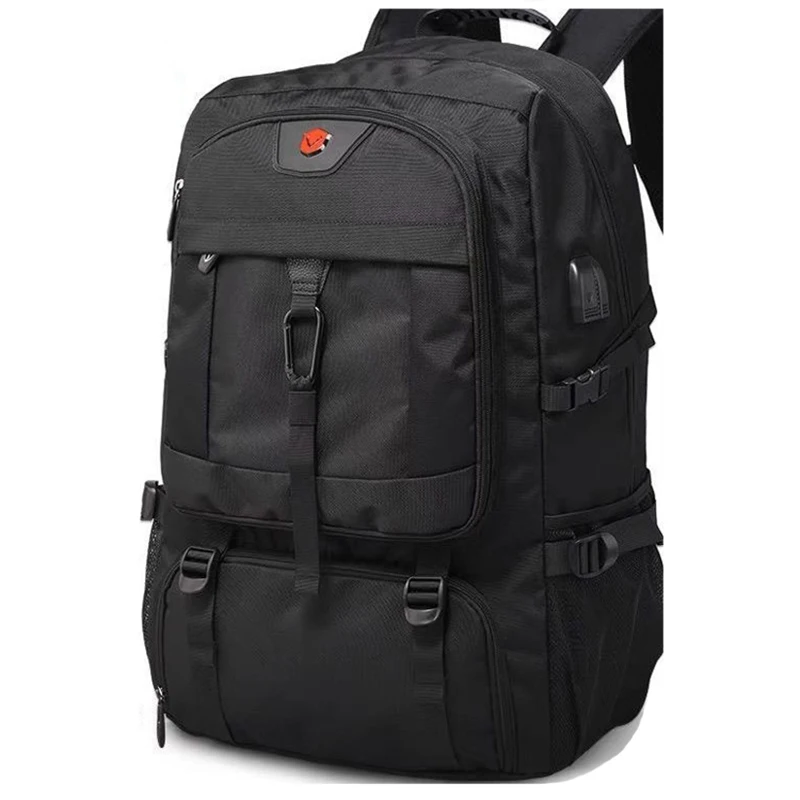
Understanding the practical implications of backpack dimensions helps ensure your selection meets your specific needs. Roll top designs offer unique sizing considerations due to their expandable nature, providing versatility that fixed-volume backpacks cannot match.
Standard Dimension Ranges
Most roll top leather backpacks fall within these general dimensions:
- Height: 16-22 inches (40-56 cm), with the extended height available when the top is unrolled
- Width: 11-14 inches (28-36 cm) at the widest point
- Depth: 4-7 inches (10-18 cm) when not fully expanded
The roll top design allows for vertical expansion while maintaining a consistent footprint, making these backpacks particularly suitable for commuters navigating crowded spaces who occasionally need extra capacity.
Understanding Capacity Measurements
Backpack volume is typically measured in liters, representing the total internal storage space:
- Compact Daily Carry: 15-20 liters accommodates essentials like a 13-inch laptop, tablet, notebooks, and personal items
- Standard Commuter Size: 20-25 liters comfortably fits a 15-inch laptop, accessories, lunch, light jacket, and daily necessities
- Expanded Capacity: 25-35 liters provides room for gym clothes, groceries, or overnight essentials in addition to work items
Roll tops uniquely offer variable capacity – a 25-liter backpack might compress to 20 liters for daily use but expand to 30+ liters when needed by adjusting the closure height.
Practical Translations
To visualize what different capacities mean in practical terms:
- 15 liters: 13” laptop, notebook, small accessories pouch, slim water bottle, lightweight jacket
- 20 liters: 15” laptop, tablet, chargers, lunch container, water bottle, light jacket, small accessories
- 25 liters: All the above plus gym clothes or a change of outfit and additional accessories
- 30+ liters: Weekend travel capacity with clothing for 2-3 days plus regular carry items
When choosing the right backpack size, consider your typical daily needs while accounting for occasional requirements that might demand additional space. The adaptable nature of roll tops allows you to optimize for average use while maintaining flexibility for exceptions.
Large leather backpacks (28+ liters) work well for those who regularly carry bulkier items or use their backpack for overnight travel, while compact models offer a more streamlined profile for minimalist everyday carry.
Practical Advantages of Roll Top Leather Backpacks
Roll top leather backpacks offer distinct practical benefits that explain their growing popularity among discerning users. These advantages stem from the unique combination of adaptable design, premium materials, and thoughtful construction.
Key Functional Benefits
Adaptive Storage: The adjustable capacity allows you to carry exactly what you need without excess bulk on lighter days or space constraints when you need to pack more.
Superior Weather Protection: The rolled closure creates natural protection against rain and snow without relying on zippers that can fail or leak.
Enhanced Security: The buckled roll top requires deliberate opening, making casual theft significantly more difficult compared to quick-access zippered bags.
Distinctive Aesthetics: The unique silhouette stands out from mass-produced designs while maintaining a timeless appeal that won’t look dated as trends change.
Investment Value: Quality leather backpacks often retain their functionality and appearance for decades rather than years, making their higher initial cost more economical over time.
Comfort Evolution: Unlike synthetic materials that break down with use, leather shoulder straps and back panels gradually conform to your body, becoming more comfortable with regular use.
Aging Gracefully: The development of patina transforms what would be “wear” on synthetic bags into desirable character on leather backpacks, making them more visually interesting over time.
Comparative Advantages
When compared to other backpack styles, roll tops offer several distinct benefits:
Vs. Flap Closures: Roll tops provide better weather protection and more adjustable capacity than traditional flap designs, though they may require slightly more time to access.
Vs. Zipper Closures: Roll tops eliminate the primary failure point of most backpacks (broken zippers) while offering expanded capacity that zippered designs cannot match.
Vs. Drawstring Closures: Roll tops provide more secure closure and better weather protection than simple drawstring designs, along with a more sophisticated aesthetic.
Alternative leather rucksack styles offer their own advantages, but the roll top design uniquely combines security, adaptability and protection in one coherent system.
The higher initial investment in a quality leather roll top backpack typically translates to better long-term value, as these designs often remain functional and attractive for 10+ years with proper care – far outlasting synthetic alternatives that might need replacement every 2-3 years.
Practical Considerations and Limitations
Despite their numerous advantages, roll top leather backpacks have certain characteristics that potential buyers should consider before purchasing. Understanding these practical aspects ensures your expectations align with the reality of owning and using these premium accessories.
Weight Considerations
Leather backpacks generally weigh more than their synthetic counterparts:
- A typical roll top leather backpack weighs 3-4 pounds (1.4-1.8 kg) empty, compared to 1-2 pounds (0.5-0.9 kg) for nylon or polyester alternatives
- The additional weight comes from the leather itself, substantial hardware, and reinforcement elements that contribute to longevity
- This weight difference may be noticeable during extended carrying periods but typically becomes less apparent as users adjust
For many owners, the durability, aesthetic appeal, and developing character of leather outweigh this consideration, but those prioritizing minimum weight may prefer technical synthetic materials.
Care Requirements
Leather requires more maintenance than synthetic materials to maintain its appearance and performance:
- Regular conditioning (typically every 3-6 months) keeps the leather supple and prevents cracking
- Proper leather maintenance for commuters includes cleaning, conditioning, and occasional retreatment for water resistance
- Understanding whether leather should dry before conditioning and other care specifics helps preserve your investment
This maintenance represents a commitment beyond what synthetic bags require but results in a product that improves rather than degrades with proper care.
Break-In Period
Quality leather backpacks often require a break-in period:
- Full-grain vegetable-tanned leather typically starts quite stiff and gradually softens with use
- Straps and contact points mold to your body shape over time, becoming increasingly comfortable
- This adaptation period varies from weeks to months depending on frequency of use and leather type
This characteristic represents both a limitation (initial stiffness) and an advantage (custom conformation to your body over time).
Price Considerations
Premium roll top leather backpacks represent a significant investment:
- Quality options typically range from $200-500, with high-end artisanal pieces exceeding this range
- This higher initial cost reflects the quality materials, skilled craftsmanship, and durability
- The long-term value proposition makes sense for those who appreciate the bag’s evolving character and extended lifespan
Understanding these practical aspects helps set realistic expectations and ensures your investment in a roll top leather backpack aligns with your priorities and lifestyle.
Ideal Use Cases and Scenarios
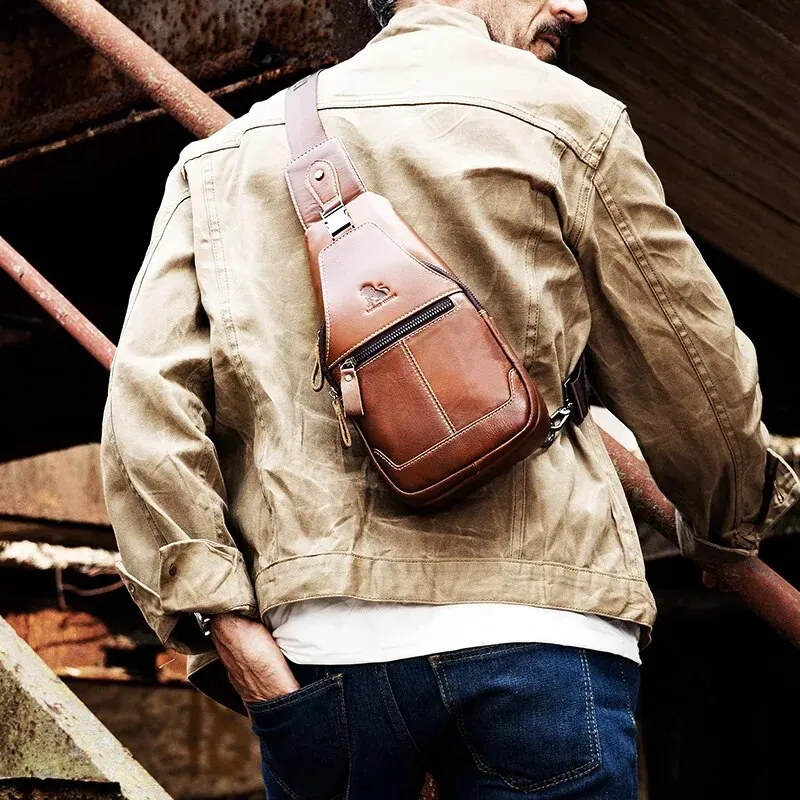
Roll top leather backpacks excel in specific scenarios where their unique combination of features provides particular advantages. Understanding these ideal use cases helps determine if this style aligns with your lifestyle needs.
Urban Commuting
The roll top design perfectly suits daily commuting in urban environments:
- The weather-resistant closure protects electronics and documents during unexpected rain showers
- Expandable capacity accommodates varying daily needs – from light carry days to occasions requiring extra space for gym clothes or groceries
- The sophisticated aesthetic transitions seamlessly from public transit to professional office environments
- Quick-access external pockets provide convenience for transit cards and phones while maintaining security for valuables
Leather work backpacks designed with professional environments in mind typically include padded laptop compartments, document sleeves, and organization for work essentials while maintaining a business-appropriate appearance.
Weekend Travel and Light Adventures
For weekend getaways and short trips, roll top designs offer practical advantages:
- Expandable capacity adapts to different packing needs without changing bags
- The secure closure keeps contents protected during transit
- The distinctive style looks appropriate in various settings from casual to upscale
- Multiple carrying options (backpack straps and top handles) provide flexibility during different travel phases
Leather travel backpacks often incorporate features like passport pockets, luggage pass-through sleeves, and more generous capacity to accommodate clothing and travel essentials.
Digital Nomad and Mobile Office Setups
For those who work remotely from different locations, roll top backpacks provide an excellent mobile office solution:
- Dedicated tech compartments protect laptops, tablets, and accessories
- Organized pockets keep cables, adapters, and small electronics accessible
- The professional appearance makes these backpacks suitable for client meetings and coworking spaces
- Weather protection safeguards valuable equipment during commutes between work locations
Photography and Creative Professional Use
Photographers and other creative professionals appreciate several aspects of roll top designs:
- The expandable main compartment accommodates camera gear or other creative equipment
- Quick access without full opening allows retrieving equipment without exposing all contents
- The water-resistant closure protects sensitive equipment from light rain
- The professional aesthetic suits client interactions while being practical for field work
These versatile backpacks adapt to various scenarios while maintaining their distinctive style and practical functionality, making them excellent companions for multifaceted lifestyles that span professional, travel, and leisure contexts.
14 Inch Leather Laptop Backpack, Brown Leather Backpack, Men's Leather Backpack, Vintage Leather Backpack
Price range: $177.28 through $199.12 Select options This product has multiple variants. The options may be chosen on the product pageCarry On Leather Backpack, Roll Top Leather Backpack
Price range: $77.76 through $96.48 Select options This product has multiple variants. The options may be chosen on the product pageDesigner Men's Backpack, Men's Leather Laptop Backpack, Men's Leather Work Backpack
Price range: $158.04 through $160.04 Select options This product has multiple variants. The options may be chosen on the product page15 Inch Leather Laptop Backpack, Leather Briefcase Backpack
$332.96 Select options This product has multiple variants. The options may be chosen on the product page17 Inch Leather Laptop Backpack, Men's Leather Travel Backpack, Men's Leather Work Backpack
Price range: $106.28 through $143.88 Select options This product has multiple variants. The options may be chosen on the product page- Price range: $80.72 through $108.04 Select options This product has multiple variants. The options may be chosen on the product page
How to Select Your Perfect Roll Top Leather Backpack
Choosing the ideal roll top leather backpack involves matching specific features to your unique needs and preferences. This methodical approach helps ensure your investment delivers long-term satisfaction.
Step 1: Define Your Primary Use Case
Begin by clearly identifying how you’ll primarily use your backpack:
* Daily work commute with laptop and essentials
* Weekend travel and overnight stays
* Versatile everyday carry for various scenarios
* Specialized use (photography, outdoor activities, etc.)
Your predominant use case should guide feature priorities – a daily commuter might prioritize laptop protection and professional appearance, while a weekend traveler might value maximum expandable capacity.
Step 2: Identify Must-Have vs. Nice-to-Have Features
Create two lists that clarify your requirements:
Essential Features:
* Size requirements (laptop dimensions, minimum capacity)
* Specific organizational needs (tech protection, document storage)
* Comfort requirements for your typical carrying time
* Weather protection level for your climate
Preference Features:
* Aesthetic style (minimalist, heritage, professional)
* Color and finish preferences
* Hardware style and finish
* Additional convenience features
Step 3: Evaluate Quality Markers
When comparing options, look for these indicators of quality construction:
- Stitching consistency and reinforcement at stress points
- Edge finishing quality and attention to detail
- Hardware substance and smooth operation
- Interior lining durability and thoughtful design
- Weight distribution when loaded
The buyer’s guide for choosing leather rucksacks provides detailed information about quality assessment techniques.
Step 4: Consider Long-Term Value
Premium roll top leather backpacks represent a significant initial investment, but their longevity often provides better value over time:
- A $300 leather backpack that lasts 10+ years costs effectively $30/year or less
- Lower-quality alternatives might need replacement every 2-3 years, potentially costing more long-term
- Consider whether the aesthetic will remain appropriate for your lifestyle over many years
Key Questions Before Purchasing
Ask yourself:
* Does the capacity adapt to both my everyday needs and occasional larger loads?
* How does the backpack feel when fully loaded with my typical items?
* Does the organization system match how I naturally organize my belongings?
* Will this design still feel appropriate for my lifestyle five years from now?
* Does the aesthetic represent my personal style while remaining versatile?
Taking time to thoroughly evaluate these factors helps ensure your roll top leather backpack becomes a trusted companion rather than a disappointing purchase.
Care, Maintenance, and Longevity
Proper care significantly extends the life of your roll top leather backpack while enhancing its developing character. Establishing simple maintenance routines protects your investment and ensures the backpack continues improving with age.
Essential Care Routine
| Care Task | Frequency | Purpose |
|---|---|---|
| Surface cleaning | Weekly or as needed | Removes dust and prevents dirt buildup |
| Deep cleaning | Every 2-3 months | Addresses accumulated oils and grime |
| Conditioning | Every 3-6 months | Replenishes natural oils, prevents drying |
| Water resistance treatment | Every 6-12 months | Maintains weather protection |
| Hardware maintenance | As needed | Prevents corrosion and ensures functionality |
The ultimate guide to conditioning leather backpacks provides detailed information about product selection and application techniques.
Addressing Common Issues
Scratches and Scuffs:
Minor scratches in quality leather can often be buffed out using gentle circular motions with a soft cloth. For deeper scratches, a small amount of matching leather conditioner applied with your fingertip can help blend the mark into the surrounding material.
Water Spots and Stains:
Allow wet leather to dry naturally at room temperature (never use direct heat). Once dry, gentle cleaning with a slightly damp cloth followed by conditioning often resolves water spotting. For stubborn spots, specialized leather cleaners formulated for your specific leather type may help.
Structural Maintenance:
Regularly check stitching and hardware for any signs of loosening. Address minor issues promptly before they develop into larger problems. Store your backpack properly when not in use – stuffed with paper to maintain shape and in a breathable cloth bag.
Storage Best Practices
- Store your backpack in a cool, dry place away from direct sunlight
- Fill the bag with acid-free tissue paper to maintain its shape
- Use a breathable cotton bag rather than plastic for long-term storage
- Apply conditioner before extended storage periods
- Check occasionally for signs of mold or mildew in humid environments
For travelers, understanding DIY leather care techniques and outdoor treatment options helps maintain your backpack even when away from home.
A comprehensive leather backpack maintenance guide provides detailed information for specific leather types and finishes.
With proper care, premium roll top leather backpacks typically develop increasing character over many years, with the leather becoming more supple and developing a rich patina that tells the story of your journeys together.
Summit Carry Premium Roll Top Collection
Summit Carry’s roll top leather backpack collection exemplifies the perfect balance between timeless craftsmanship and contemporary functionality. Each backpack reflects our commitment to creating leather goods that serve as daily companions throughout life’s adventures rather than temporary accessories.
Our design philosophy centers on thoughtful minimalism – including only features that serve genuine purpose while executing each detail with precision. This approach results in backpacks that feel intuitively organized without unnecessary complexity.
The Summit Carry roll top collection features select full-grain leather that undergoes minimal processing to preserve its natural character and strength. Our master craftspeople use traditional techniques including saddle stitching at critical stress points, burnished edges, and reinforced construction that ensures decades of reliable use.
We distinguish our roll tops through thoughtful features like our signature adjustable closure system that combines security with quick access, padded laptop compartments with suspended construction to protect devices from impacts, and ergonomically designed shoulder straps that distribute weight optimally for all-day comfort.
Each Summit Carry backpack represents our belief that premium leather goods should not only be beautiful when new but should develop increasing character with use – becoming more distinctly yours with each journey.
Frequently Asked Questions About Roll Top Leather Backpacks
How long does a quality leather roll top backpack typically last?
With proper care and maintenance, a premium full-grain leather roll top backpack can easily last 10-20 years of regular use. Many owners report their quality leather bags developing better character and functionality after years of use rather than showing signs of wearing out. The longevity depends significantly on the leather quality, construction methods, and how well the backpack is maintained.
Can roll top leather backpacks be used in rainy conditions?
Roll top closures provide inherent weather resistance superior to most zippered or flap designs. When combined with treated leather and proper leather conditioning and waterproofing, these backpacks handle light to moderate rain quite well. However, extended exposure to heavy rain without additional protection may eventually allow moisture to penetrate, particularly through seams. For regular use in very wet conditions, consider supplemental waterproofing treatments.
How do I break in a new leather backpack?
The most effective way to break in a leather backpack is through regular use. The natural oils from handling, body heat, and movement gradually soften the leather and conform it to your body. You can accelerate this process slightly by applying a quality leather conditioner after the first few weeks of use, which helps the leather fibers become more supple. Avoid artificial breaking-in methods like excessive bending or soaking, as these can damage the leather’s structure.
Are leather backpacks suitable for travel?
Leather roll top backpacks make excellent travel companions, particularly for urban and light adventure travel. Their expandable capacity adapts to varying packing needs, while their security features and weather resistance protect contents during transit. The professional aesthetic also transitions well between different environments. However, for extreme outdoor adventures or backpacking trips where weight is critical, specialized technical packs may be more appropriate.
How should I store my leather backpack when not in use?
Store your leather backpack in a cool, dry environment away from direct sunlight, which can fade and dry the leather. Fill it with acid-free tissue paper to maintain its shape, and use a breathable cotton bag rather than plastic for long-term storage. Apply conditioner before extended storage periods to prevent the leather from drying out. Occasionally check stored leather goods for signs of mold or mildew, particularly in humid environments.
Can leather backpacks hold heavy loads comfortably?
Quality leather backpacks with proper ergonomic design can comfortably support moderate loads (up to about 15-20 pounds). The key factors affecting comfort are the shoulder strap design, back panel construction, and weight distribution. Premium backpacks often feature padded straps that distribute weight across a wider area and back panels that maintain structure even when fully loaded. However, for consistently heavy loads, backpacks with additional support features like sternum straps and padded hip belts may offer better long-term comfort.

